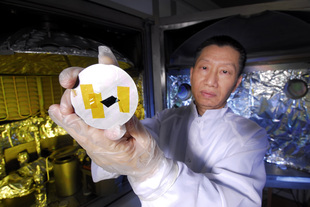Apr 24 2008
Researchers have developed an improved organic light emitting diode (OLED) sealing process to reduce moisture intrusion and improve device lifetime.
 GTRI senior research scientist Wusheng Tong uses ion assisted deposition to produce a high-density, pinhole-free thin silicon oxynitride film on an organic light emitting diode surface, which reduces moisture intrusion.
GTRI senior research scientist Wusheng Tong uses ion assisted deposition to produce a high-density, pinhole-free thin silicon oxynitride film on an organic light emitting diode surface, which reduces moisture intrusion.
OLEDs are promising for the next generation of displays and solid state lighting because they use less power and can be more efficiently manufactured than current technology. However, the intrusion of moisture into the displays can damage or destroy an OLED’s organic material.
“OLEDs have better color and flexibility and the capability of larger displays, but companies still need an inexpensive encapsulation method that can be used to mass produce organic electronics that don’t allow moisture in,” said Wusheng Tong, a senior research scientist at the Georgia Tech Research Institute (GTRI).
Manufacturers now seal displays in an inert atmosphere or in a vacuum environment. They glue a glass lid on top of the display substrate with a powder inside the display to absorb moisture that diffuses through the glue. These seals are expensive and labor-intensive to assemble.
With funding from GTRI’s independent research and development program, Tong and his GTRI collaborators – senior research scientist Hisham Menkara and principal research scientist Brent Wagner – have replaced the glass enclosure with a thin-film barrier formed by a less expensive conventional deposition method.
“We chose a passivation coating process that could be performed at room temperature so that the organic material remained intact,” said Tong.
The researchers selected advanced ion assisted deposition, which utilizes reactive ions to deposit a high-density, pinhole-free thin silicon oxynitride (SiON) film on the OLED surface.
“Ideally, the film should be as thin as possible, but if it’s too thin, a pinhole or other defect could appear and cause a problem,” explained Tong. “We found that a film of 50-200 nanometer thickness was perfect.”
During testing, the SiON-encapsulated OLEDs showed no sign of degradation after seven months in an open-air environment, while the OLEDs without the coating degraded completely in less than two weeks under the same conditions.
When Tong conducted accelerating aging tests in an environmental chamber that maintained a temperature of 50 degrees Celsius and 50 percent relative humidity, the OLEDs encapsulated with SiON films showed little degradation for at least two weeks. The OLEDs without encapsulation, however, decomposed immediately.
“We’ve demonstrated that this deposition process improves the lifetime of the OLEDs by blocking the intrusion of moisture, so now we’re hoping to work with industry partners to develop a mass production process for our encapsulation technique,” added Tong.
Posted April 23rd,2008